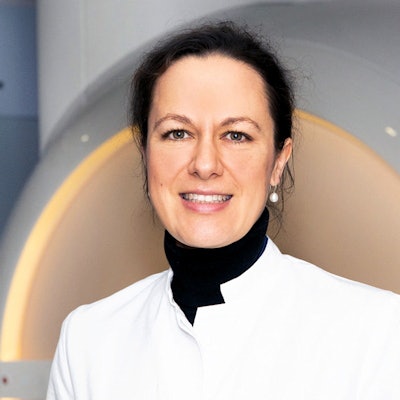
Everybody involved in the medical imaging sector needs to know about artificial intelligence (AI). The Junior Academy in Medical Technology (NAMT-10) is a medical technology academy that aims to develop awareness of the field. It is promoted by the German Research Foundation (DFG).
In this Q&A interview with the German Röntgen Society (DRG), Prof. Dr. Ulrike Attenberger, head of diagnostic and interventional radiology at the University Hospital Bonn (UKB) and scientific coordinator for NAMT-10 discusses the goals and work of the academy.
Q: "Artificial intelligence in radiology" is the motto of NAMT-10. Why is AI so important?
 Prof. Dr. Ulrike Attenberger. Image courtesy of the UKB.
Prof. Dr. Ulrike Attenberger. Image courtesy of the UKB.A: AI defines the next technological wave. We have had various technological waves in the history of radiology, beginning with the invention of x-rays, followed by the introduction of CT, MRI, and so on. Artificial intelligence (AI) is important for radiology precisely because we are in the age of so-called precision medicine or individualized medicine. We want to offer our patients the most suitable, individually tailored therapy possible. The prerequisite for this is an extremely differentiated diagnosis, and AI is a very important success factor here. In addition, AI can also help to make the workflows in radiology departments more efficient, for example by helping to sort image data according to urgency.
We are currently experiencing a dramatic increase in image data combined with the threat of a shortage of skilled workers due to demographic change. AI is essential for medicine, but above all for high-performance radiology.
Q: What are the goals of NAMT-10?
A: The main goal is to promote the marriage of medicine and computer science or mathematics. The aim of the junior academy is to bring junior researchers from both areas together so that an interdisciplinary network is created that forms the basis for new cooperation models -- first of all for scientific cooperation models, which are then also viable for clinical translation.
Here too, radiology can play a pioneering role. We are used to working very closely with medical physics, for example, when it comes to the clinical evaluation of new imaging techniques, and now it is time to take the next step. To bring AI into the clinic, the two disciplines of medicine and mathematics have to learn to speak to each other, and they have to understand where they can rely on each other and their respective needs and requirements.
The essential goal of this junior academy is the formation of a network between medicine and
mathematics based on concrete research projects.
Q: What requirements do interested young scientists have to meet and how can they become involved?
A: The target group is colleagues who are at an early stage in their academic careers. We have a focus on radiological imaging, but in principle, this junior academy is open to nuclear medicine and radiation therapy, i.e., our neighboring subjects, as well as to digital pathology and all other areas that are related to image data in a medical context, as well as computing, and biostatistics.
It is best to already have a doctorate or to be about to do a doctorate and have some initial scientific experience. Perhaps you might already be working on a first project. You should be in a fairly early stage of your scientific career, but of course not so early that you haven't had some initial experience.
Q: What is the deadline for applications?
A: The deadline for submitting your application documents is 30 October 2021. We will then give applicants a response by December 2021 as to whether they can participate. An interdisciplinary consortium will evaluate the applications. To do this, we need a project outline with a maximum of four pages, a current curriculum vitae consisting of a maximum of two pages, and, if available, a list of publications and conference contributions. Travel costs, accommodation, and meals are covered. The cost for the participants is 100 euros.
The first part of the junior academy will take place from 25 to 29 April 2022 in Bonn, where the participants will learn, among other things, how to best submit a DFG application. In the second part of the junior academy, the participants draft the final DFG proposal with the help of their project outline. To do this, you apply the knowledge you acquired in the first part of the course. A summary of this information is provided on the UKB website.
Q: Is this a results-oriented scheme with a hands-on mentality?
A: That's correct. We have set up a very varied program for the first part of the junior academy: It will be a mix of hands-on hackathons in which the participants can already work with data in a practical way. We have a close cooperation with the Computational Imaging Research Lab of the University Clinic for Radiology and Nuclear Medicine (Head: Prof. Dr. Christian Herold) from the Vienna General Hospital. Prof. Georg Langs, who heads the Research Lab, and his team will give support.
Doctors do not need to be afraid. They will be introduced to this in a hands-on manner with either their own anonymized data or with test data that we provide. In addition, the workshop will be supplemented by seminars and panel discussions. There will be public lectures that also open up perspectives beyond medicine such as other fields of AI application. In order to get the colleagues ready to submit the DFG proposal, there are extra lectures and seminars in which you learn the "dos and don'ts" in order to successfully submit the DFG proposal. So it will be a really exciting and packed week.
Q: Speaking of dos and don'ts, do you have any tips on what applicants should pay particular attention to in their project outlines?
A: Giving the ultimate tip is of course always a bit difficult. But in this case, it is very important that the applications are made in pairs, i.e., with representatives from both medicine and mathematics/computer science. Interdisciplinary project funding is ultimately the aim of the junior academy. It is always important to have a specific goal that you want to achieve with your research project. This goal shouldn't be too diffuse. It might be challenging, but it must be feasible, and the project idea should be clear. The more concrete a project idea is, and the more detailed and comprehensible the milestones that are required for implementation, the more promising the application is in most cases.
Q: Why should young scientists apply for NAMT-10?
A: You should apply because the tools you acquire in NAMT-10 give you the opportunity to specifically shape the near future, not only of radiology, but of medicine in general. AI will be the hot topic in all areas of medicine and a springboard for the latest developments. Based on its history, radiology has always been at the forefront of innovation. So if you want to actively shape the future, you are welcome -- and definitely at the right address with the junior academy.
Information at a glance: You can apply now for the DFG's Tenth Junior Academy Medical Technology under the motto "Artificial Intelligence in Radiology." The deadline is 30 October 2021. Up to 20 people will be accepted. The funding period is one year. The prerequisite for your application is that you have completed academic training and have recently obtained your doctorate. In addition, the financial scope of your project should not exceed 50,000 euros.
Editor's note: This is an edited version of a translation of an article published in German by the DRG. Translation by Frances Rylands-Monk. To read the original version, go to the DRG website.



















